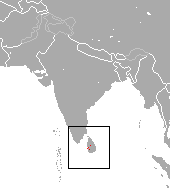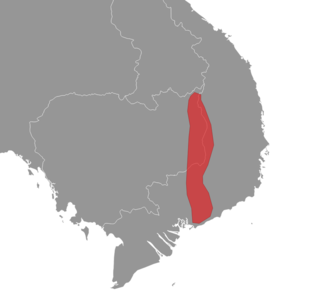
The genus Crocidura is one of nine genera of the shrew subfamily Crocidurinae. Members of the genus are commonly called white-toothed shrews or musk shrews, although both also apply to all of the species in the subfamily. With over 180 species, Crocidura contains the most species of any mammal genus. The name Crocidura means "woolly tail", because the tail of Crocidura species are covered in short hairs interspersed with longer ones.

The Asian gray shrew is a species of mammal in the family Soricidae. It is found in Bhutan, Cambodia, China, India, Laos, Malaysia, Myanmar, Nepal, Pakistan, the Philippines, Thailand, and Vietnam. It is one of the commonest species within its range and the International Union for Conservation of Nature has assessed its conservation status as being of "least concern".

Hildegarde's shrew is a species of mammal in the family Soricidae. It is found in Burundi, Cameroon, Central African Republic, Republic of the Congo, Democratic Republic of the Congo, Ethiopia, Kenya, Rwanda, and Tanzania. Considered by some authorities to be a subspecies of Crocidura gracilipes, it is now recognised as a separate species, with a diploid chromosome number of 2n = 52. This is one of three species of small mammal named by the British zoologist Oldfield Thomas in honour of anthropologist Hildegarde Beatrice Hinde.

Horsfield's shrew is a species of mammal in the family Soricidae found in Cambodia, China, India, Japan, Laos, Nepal, Bhutan, Sri Lanka, Taiwan, Thailand, and Vietnam.

The Sulawesi shrew is a species of mammal in the family Soricidae. It is endemic to the central and northern provinces of Sulawesi in Indonesia. It is a fairly common species and the International Union for Conservation of Nature has assessed its conservation status as being of "least concern".

The swamp musk shrew, or musk shrew, is a species of mammal in the family Soricidae. It occurs in Angola, Botswana, Democratic Republic of the Congo, Mozambique, Namibia, South Africa, Eswatini, Zambia and Zimbabwe. Its natural habitat is swamps, and it is a common species in suitable habitats, with the International Union for Conservation of Nature listing it as being of "least concern".

The Sri Lankan long-tailed shrew is a species of mammal in the family Soricidae. It is endemic to Sri Lanka. It is threatened by habitat loss.

The Ugandan musk shrew is a species of mammal in the family Soricidae. It is found in Uganda, the Democratic Republic of Congo and the Central African Republic. Its range, population size and habits are poorly known.

The black-footed shrew is a species of mammal in the family Soricidae. It is endemic to northern and central Sulawesi, Indonesia where it lives on the floor of the tropical forests. The International Union for Conservation of Nature has assessed its conservation status as being of "least concern".

The Sulawesi white-handed shrew or Temboan shrew is a species of mammal in the family Soricidae. It is endemic to the island of Sulawesi in Indonesia. It is a fairly common species and the population seems stable so the International Union for Conservation of Nature has assessed its conservation status as being of "least concern".

The jungle shrew is a species of mammal in the family Soricidae endemic to Sri Lanka. Its natural habitat is subtropical or tropical dry forests. It is threatened by habitat loss.

Crocidura phanluongi is a species of shrew in the genus Crocidura from southern Vietnam and nearby Cambodia. It is a somewhat small, gray shrew with an ecologically diverse distribution.

The Panay shrew is a species of shrew from the Philippines.

The Batak shrew is a species of shrew from the Philippines.
The Javan hidden shrew or Javan long-tailed shrew is a species of mammal in the family Soricidae. It is endemic to the island of Java in Indonesia.
The Fingui white-toothed shrew or Principe white-toothed shrew is a species of mammal in the family Soricidae. It is endemic to the island of Príncipe in São Tomé and Príncipe.
The Lwiro shrew or Misotshi-Kabogo shrew is a species of mammal in the family Soricidae. It is endemic to the Democratic Republic of the Congo.
Newmark's shrew is a species of mammal in the family Soricidae. It is endemic to Tanzania.
The Dracula shrew, also known as the large white-toothed shrew, is a species of mammal in the family Soricidae. It is found in Vietnam, Laos, and adjacent southern China, with possible range extension into Cambodia east of the Mekong River. Because it is so visually similar to the Southeast Asian shrew, it has historically been considered part of the same species complex and the range delineation between the two species is still being resolved. Recent genetic evidence strongly supports that the Dracula shrew is in fact a uniquely diverged species.
Sokolov's shrew is a species of mammal in the family Soricidae. It is endemic to Vietnam.














